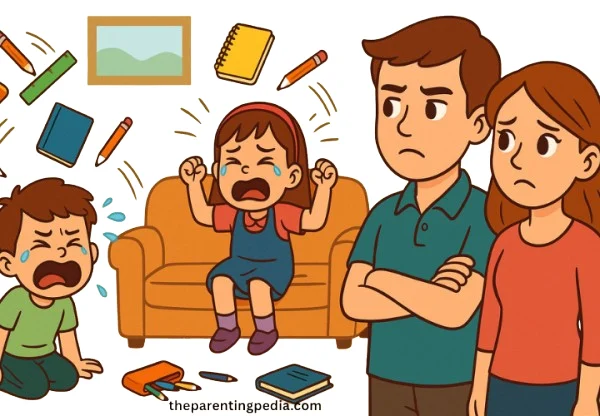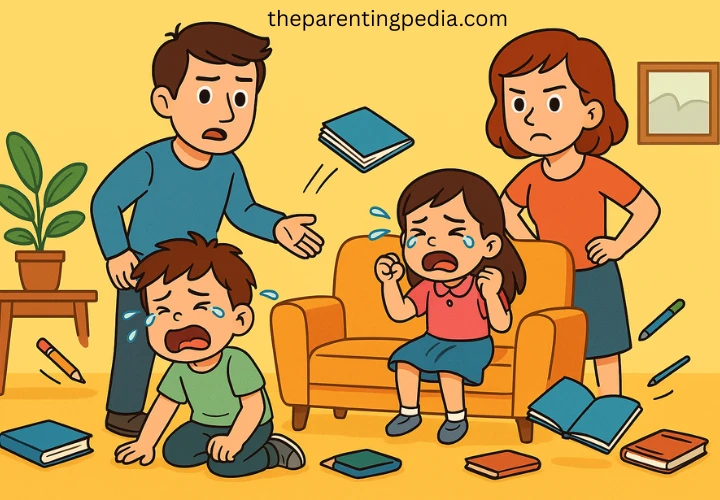Toddler tantrums are one of the most universally experienced and universally misunderstood challenges of early childhood. From the screaming fits in grocery store to the refusal to eat meals or go to bed, tantrums can take many forms. While they are a normal part of development, not all tantrums are the same. Recognizing different types of toddler tantrums including stubborn toddler tantrums, aggressive tantrums, extreme temper tantrums and severe temper tantrums is essential for parents, caregivers and educators to respond with understanding, consistency and effective strategies.
Why Do Toddlers Have Tantrums?
Tantrums usually begin between 12 and 18 months, peak between 2 and 3 years, and reduce significantly around age 4.Toddler tantrums can be described as emotional outbursts coming from frustration, overstimulation, exhaustion, hunger, or an inability to communicate effectively.
Toddlers are still learning to manage their emotions and often lack the vocabulary or self-control to express themselves calmly. As a result, when things don’t go their way, they may explode in dramatic, sometimes alarming ways. While some tantrums are brief and can be easily calm down, others may be prolonged and intense. Following are the major types of toddler tantrums parents encounter and how to identify and manage them.
1. Stubborn Toddler Tantrums
These tantrums are triggered when a toddler strongly insists on having things their way. Often linked to a child’s growing desire for independence, stubborn tantrums are typically ingrained from power struggles. Following are the characteristics of stubborn toddler tantrums:
- The child adamantly refuses to follow instructions.
- Such types of toddler tantrums are often silent protests from children. Example of such toddler tantrum is sitting down and refusing to move.
- Occurs when a child is told “no” or is asked to do something they don’t want to.
- Crying or yelling might accompany the refusal.
Example: A toddler refuses to wear shoes before going outside, screaming and kicking until allowed to go barefoot.
How To Handle Stubborn Toddler Tantrums?
- Stay calm and firm: Giving in to demands accompanied by toddler tantrums reinforces the behavior.
- Offer limited choices: Offer limited offers to toddlers like “Do you want to wear the red shoes or the blue shoes?”
- Use distraction: Such types of toddler tantrums can be avoided by using distraction for younger toddlers.
- Set clear boundaries: Set clear boundaries for children and follow through with consequences.

Aggressive Toddler Tantrums
Some toddlers express their anger physically through hitting, biting, kicking, or throwing objects. Such types of toddler tantrums are called aggressive toddler tantrums. These aggressive tantrums can be distressing and potentially harmful to others. Following are the characteristics of aggressive toddler tantrums:
- Physical aggression toward parents, siblings, or objects.
- Loud yelling or screaming towards others.
- Aggressive toddler tantrums often occur when a child feels cornered, rejected, or overwhelmed.
Example: A toddler is told it is time to leave the park and he responds by hitting the parent and throwing a toy.
How To Handle Aggressive Toddler Tantrums?
- Ensure Safety First: Remove any objects that could cause harm to toddlers.
- Intervene Immediately: During such types of toddler tantrums, intervene immediately and consistently to stop aggressive behavior.
- Use of calm language: Use calm and firm language in front of toddlers. Hitting is not okay. Help them calm down.
- Identify their feelings: After the tantrum, help toddler in identifying their feelings and expressing them in words.
- Consultation: If persistent aggression continues, consider consulting a pediatrician or child psychologist.
3. Extreme Temper Tantrums
Such types of toddler tantrums are long, loud, and intense. The child might cry for a long time, fall to the floor, kick, or scream without stopping. They may not calm down easily.
Example: Your toddler wants a candy at the store. You say no. They cry loudly, scream, lie on the floor and don’t stop even after you leave the store.
Also Read: How Digital Media Affects Children: Benefits and Drawbacks
Why Extreme Temper Tantrums happen?
- The child has a very strong reaction to not getting what they want.
- Toddlers feel helpless or overwhelmed.
- Toddlers may be tired or overstimulated because of too much noise or activity.
How To Handle Extreme Temper Tantrums?
- Don’t give in. If parents have said no, they should stick to it.
- Stay calm and wait nearby, even if others are watching.
- Speak softly and don’t argue or try to reason during the tantrum.
- After it is over, talk about what happened and how they can behave next time.
- Make sure your child is getting enough sleep, rest, and food. This can really help prevent such types of toddler tantrums.
4. Severe Temper Tantrums
Severe tantrums are very intense and may happen very often. Such types of toddler tantrums can include toddlers hurting themselves like hitting their own head, hurting others or tantrums lasting longer than 30 minutes.
Example: Your child gets upset when it is time to leave the park. They scream loudly, hit themselves, bite others or cry non-stop for almost an hour.
Why Severe Temper Tantrums happen?
- There may be deeper emotional or developmental issues.
- The child might have trouble controlling their emotions even as they get older.
- Sometimes these tantrums are a sign of conditions like ADHD, autism or sensory problems.
How To Handle Severe Temper Tantrums?
- Make sure your child and others are safe during such types of toddler tantrums.
- Do not yell, threaten, or punish harshly. It may not help.
- Keep a record of when and how often severe temper tantrums happen.
- Talk to pediatrician or a child psychologist if needed.
- Such child may need extra help from experts in behavior or development.
Helpful Tips For All Types Of Toddler Tantrums
1. Stay Calm: Parents should understand that your child is learning from you. If they shout, children will too. If they stay calm, it helps children calm down faster.
2. Keep a Routine: Having the same schedule for meals, naps and play time can reduce stress on children and make them feel safe.
3. Give Choices: Let them choose between two things. For example: “Do you want apple or banana?” It helps children feel control in a good way.
4. Praise Good Behavior: Notice when your child is behaving well. Say things like, “I love how you used your words!” or “Great job putting your toys away!” This helps your child feel proud and encourages them to repeat the good behavior.
5. Watch for Triggers: Some types of toddler tantrums happen when kids are tired, hungry or overwhelmed. Plan ahead for such situations. Bring snacks for them or avoid taking toddlers to busy places when they are sleepy.
When to Get Help?
Most tantrums are normal and go away as children grow. But talk to your doctor if:
- Tantrums are violent or destructive.
- Your child seems to be hurting themselves or others frequently.
- Your child is over age 5 and still regularly has tantrums.
- You feel exhausted or overwhelmed in handling daily behavior of children.

Conclusion
Toddler tantrums are challenging, messy, and sometimes embarrassing, but they are also a sign that your child is learning to deal with emotions. Understanding different types of toddler tantrums help caregivers to respond with empathy rather than frustration or fear. From stubborn refusals to aggressive outbursts, from extreme meltdowns to severe behavioral concerns, all types of toddler tantrums are an opportunity to teach self-regulation, communication and coping skills. And while it may not feel like it in the heat of the moment, this phase of tantrums do pass. With parents consistent support and guidance, children will come out stronger on the other side.
FAQ
What are the different types of tantrums in toddlers?
Toddlers can have different types of tantrums such as stubborn tantrums, aggressive tantrums, frustration tantrums, extreme temper tantrums and severe tantrums caused by reasons such as hunger, tiredness, overstimulation or emotional overload.
How to deal with uncontrollable toddler tantrums?
Stay calm, ensure safety, avoid yelling, give them space to cool down, offer comfort once they settle, maintain routines, set clear limits and talk gently afterward to teach better ways to express feelings to children.
